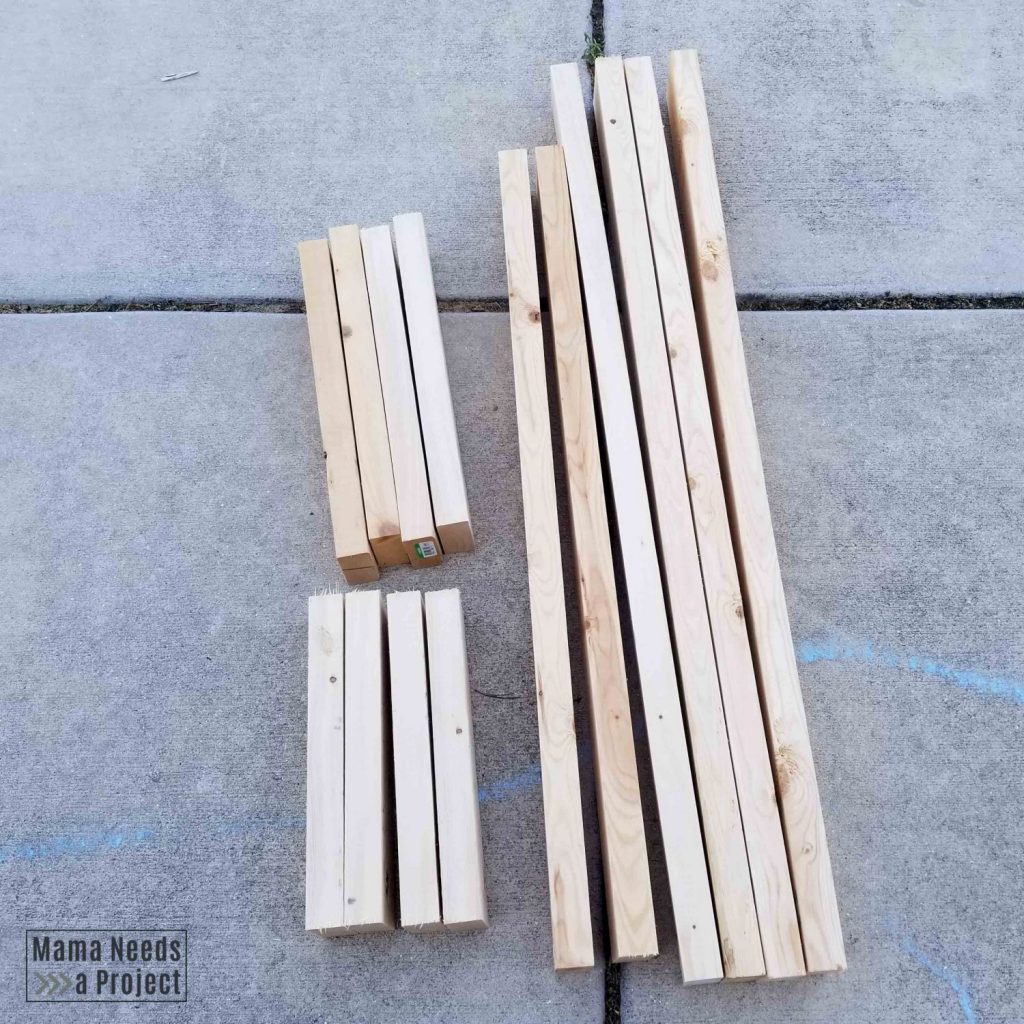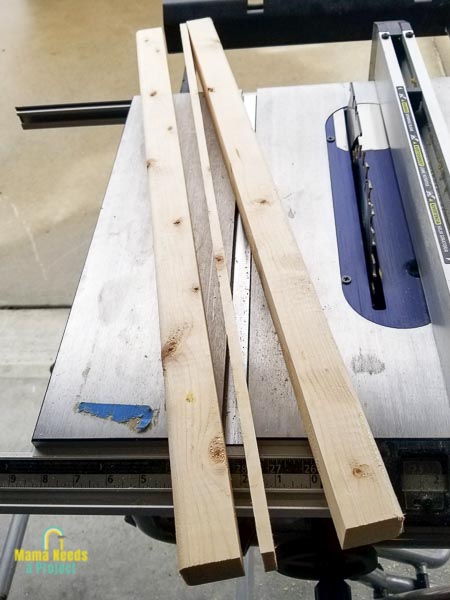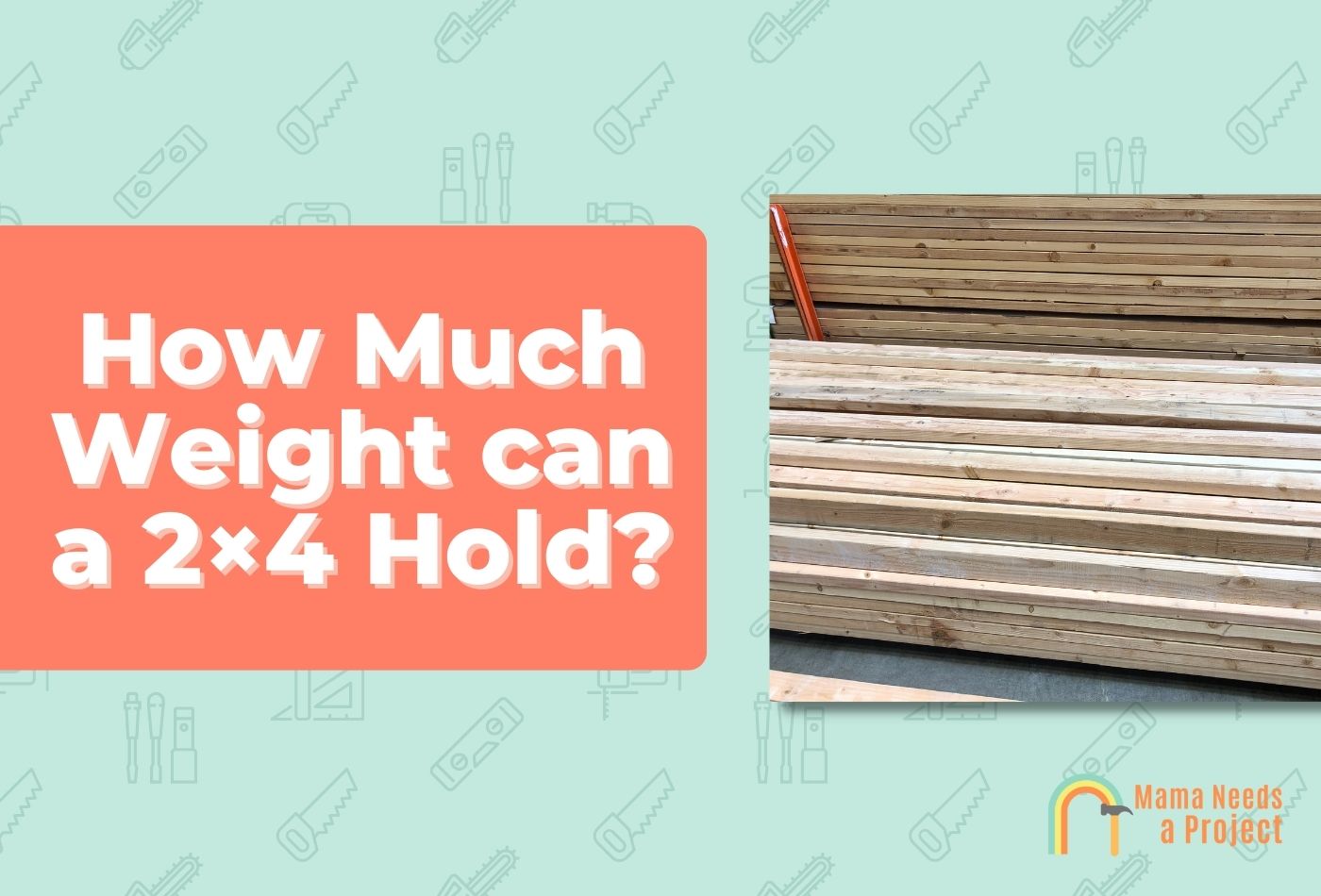How Much Weight can a 2×4 Hold? (Quick Answer!)
2x4s are used all the time for small DIY projects, home building, structural reinforcement—the list goes on and on.
But one question people always seem to have regarding these very common boards is: how much weight can a 2×4 hold?
The weight load capacity is critical to know so you can determine how much structural strength your project can support.
- Horizontally, a 2×4 can support 20-40 lbs of evenly distributed weight. Vertically, a 2×4 can support up to 1,000 lbs. On its edge, a 2×4 can support up to 300 lbs.
- Wood type, grade, moisture content, and span all collectively determine the maximum weight a 2×4 can support. Hardwood, high-grade 2x4s tend to support greater weight.
How Much Weight Can a 2×4 Hold Horizontally?

Unless the ceiling joists underneath are spaced properly, a 2×4 won’t be able to hold a substantial weight horizontally.
Most 2x4s can hold 20-40 lbs per square foot, but this is only if the weight is evenly distributed throughout the span.
If weight isn’t evenly distributed—if it’s focused in the center of the board, for example—the 2×4’s supportive capacity goes way down (≤20 lbs per square foot).
2x4s made of hardwood can generally hold more weight horizontally (~70 lbs).
You can also check out this guide to understand how much weight a 4×4 can hold and how much a 2×6 can hold!
How Much Weight Can a 2×4 Hold Vertically?

Generally speaking, 2x4s are strongest when they’re upright. In this position, a 2×4 can support up to 1,000 lbs.
Because they have such a high load-bearing capacity, they’re often used as wall studs. The standard configuration is to have these boards 16 inches apart from one another.
A group of 2x4s positioned this way can support 10,000-20,000 lbs, which is more than enough support for standard houses.
Did you know that a 2×4 isn’t actually 2″x4″? Check out this guide to understand the actual size of a 2×4!
How Much Weight Can the Edge of a 2×4 Hold?
It may come as a surprise, but most boards are much stronger when turned on their edges, mainly because edges tend to be thicker (~3.5”) than surfaces (~1.5”).
The edges of joists, for example, are used to ensure maximum floor support.
Most 2×4 edges can support up to 300 lbs of evenly distributed weight, but how much weight a 2×4 edge can support depends on a variety of factors that I discuss in detail in a later section.
How Much Weight Can a 2x4x8 Support Horizontally
2x4x8s are usually used as wall studs, and it’s not often that they’re laid horizontally as structural lumber.
That said, a 2x4x8 laid horizontally doesn’t have a significant weight capacity (just 20-40 lbs per square foot).
And if there’s too much weight centered in the middle of the board, a 2x4x8’s weight capacity shrinks to less than 20 lbs per square foot.
Despite being labeled 2x4x8s, most of these boards are actually 1.5×3.5×9.6—but these measurements don’t roll off the tongue as easily.
What Affects the Load Capacity of a 2×4?
Type of Wood
Wood type is one of the most important factors when it comes to determining how much weight a 2×4 can bear.
Generally speaking, hardwoods can hold more weight than softwoods, and kiln-dried lumber can hold more weight than green wood.
Hardwoods:
Hardwoods like oak, maple, hickory, and Southern yellow pine are tougher, denser, and heavier than other woods and wood-based materials, and for these reasons they tend to retain load capacity for longer.
These woods can withstand constant pressure for long periods of time, whether standing vertically or in a horizontal position.
And since hardwood is denser wood, it does better with weight distribution, which explains why it’s often used when an evenly distributed load is essential.
Softwoods:
Softwoods aren’t as strong as hardwoods, so generally they don’t support as much weight. That said, the difference is usually a few pounds at most.
Moreover, some softwoods—like Douglas fir—have a lot of the qualities hardwoods possess, and these species can retain their weight capacity longer than many hardwoods.
Kiln-Dried Wood:
Kiln drying is a process wood must go through before it can be considered construction grade. When dried at a super-high temperature, the 2×4 is reinforced, making it ideal for exterior walls and other construction projects.
But not all lumber is kiln-dried. It’s possible to air-dry lumber too. But air-dried lumber isn’t as strong, and it takes awhile for air to completely dry lumber.
Green Wood:
Green lumber is a term used to describe wood that’s been cut recently. Usually, green lumber has high moisture content, which means it’s not capable of supporting substantial weight.
That said, green lumber is a preferred wood for some outdoor applications, since it’s moisture-resistant and less prone to rotting.
Grade of Wood
Virtually all lumber is graded on a scale, with utility-grade being lowest and construction-grade being highest.
Lumber grade is relevant when it comes to weight capacity. Specifically, lower-grade lumber tends to not support as much weight as higher-grade lumber.
Most home improvement stores sell both kinds of lumber, and sometimes it can be hard to tell the difference between low-grade and high-grade stuff, especially if things aren’t labeled correctly.
In short, higher-quality lumber is best for heavy loads, when it’s laying horizontally or standing upright.
Moisture Content
Moisture content is another important factor that in part determines how much weight a 2×4 can support.
Generally speaking, woods that are naturally moist—as well as those that are prone to being over-saturated with moisture—tend to not support as much weight as dryer woods.
That said, many moister wood species offer attractive load duration—they just require more maintenance.
Say, for example, you live in a climate where the temperature often fluctuates rapidly. A moister wood will be more prone to warping, unless it’s treated in advance to prevent this.
Span
Span is an important factor as well, especially when it comes to weight distribution. Essentially, the greater the span, the more weight can be held without the assistance of vertical supports.
But even 2x4s with larger spans are almost always supported with joists or poles, since longer span plus more underneath support equals more weight capacity overall.
Live Load vs Dead Load
Both live load and dead load are crucial factors that builders consider. A structurally sound building will have neither too much live load nor too much dead load.
Live Load
Live load refers to the factors that change how much weight (pressure) is applied to the lumber.
For example, if you have a party, the live load will go up significantly, since there will be many people walking around your home.
Live load is also relevant when roofers are doing work over your head.
Furniture too, despite having a consistent weight, is considered live load. And when snow piles up on your roof in the winter, this too will add to the overall live load.
Obviously, live load is an incredibly important factor to consider during a building project, as not compensating for a substantially increased live load could result in some kind of collapse.
Typically, 2×4 floor joists with a 6’5” span that are spaced 16 inches apart can handle 40 lbs per square inch of live load.
Dead Load
Dead load, otherwise known as dead weight, refers to the collective weight of all permanent fixtures, including trusses, drywall, rafters, and joists.
Even though these fixtures are permanent, they don’t have a collective constant weight, since materials break down over time.
How Much Weight Can a Pressure-Treated 2×4 Hold?
Pressure-treated wood may be able to withstand the elements better than natural woods, but this strength has no bearing on its weight capacity.
In other words, you can expect pressure-treated woods to support just as much weight as natural woods—horizontally, vertically, or at the edge.
That said, there are different species of pressure-treated wood, and each species has different grades.
Generally speaking, pressure-treated hardwoods have more weight capacity than pressure-treated softwoods, which explains why they’re often used to construct exterior structures, like decks, porches, sheds, and garages.
And since pressure-treated wood can resist erosive elements for longer, it takes quite a long time for this material to wear down, meaning it retains its full weight capacity for many years.
Do 2x4s Weaken Over Time?
Yes, 2x4s weaken over time. How much your 2x4s weaken, and how fast, largely depends on what they’re made of (wood species), wood quality (grade), and the kinds of erosive elements they’re exposed to routinely.
The following factors can slowly weaken 2x4s over time:
The Elements (Wind, Rain, Humidity, Sunlight, Etc.)
Wind, rain, humidity, sunlight, and other natural factors can slowly erode 2x4s over time, weakening them so they can’t support as much weight.
So if you’re concerned about the elements wreaking havoc on your 2x4s, use pressure-treated hardwoods, as these will hold up best for a long time (if properly maintained).
Mold
Mold grows in damp places and can spread quickly once it gains a foothold. And all the while, it’ll damage the materials it’s overcome, especially natural materials like wood.
So if your light framing, for example, has been covered with mold for many months, there’s a very good chance it’s been significantly weakened and probably should be replaced.
Foot Traffic
If arranged the right way, 2x4s have pretty decent load bearing capacity. But this gets reduced by the wear and tear caused by general foot traffic.
So if your house has had a deck for many years, it’s likely you’ll hear lots of creaking when walking around on it; this is a sign the boards are generally weak and probably should be replaced.
Pests
Certain pests, like termites, can greatly reduce a 2×4’s weight capacity. Some wood species are especially prone to infestations, and rarely are these woods used as structural support.
Generally speaking, denser hardwoods are more naturally resistant to most pests. That said, it’s still best to get pressure-treated wood (if you can) since it offers the best protection against a range of common pests.
What’s the Compressive Strength of a 2×4?
The term “compressive strength” is often used to refer to how much weight a piece of wood can handle when pressure is applied with the grain.
Stiffness, on the other hand, often refers to how much weight can be supported when pressure is applied perpendicularly (against the grain).
Usually, 2x4s have a compressive strength around 1,000 lbs. Again, compressive strength is in large part determined by the factors discussed above.
What Is 2×4 Stiffness?
The weight a perpendicular 2×4 can support before bending is known as its stiffness. Sometimes this is called “bending strength”.
Most 2x4s have a stiffness of 875 lbs per square inch, but numerous factors collectively determine the stiffness of a board.
Are Two 2x4s as Strong as One 4×4?
Many individuals falsely believe that nailing together two 2x4s makes a 4×4 post. This mistake is a result of many people not knowing the difference between dimensional lumber and actual dimensions.
Remember, 2×4 isn’t a totally accurate term—these boards are really 3.5 inches wide and 1.5 inches deep.
So if you were to nail two 2x4s together, what you’d get is a piece of wood that’s still 3.5 inches wide but now 3 inches deep.
4x4s, on the other hand, have a larger width (3.5 inches).
How much more support does a 4×4 offer? Well, an 8-foot, 3.5-inch thick board can usually support up to 6,500 lbs.
Final Thoughts
To recap, the amount of weight (load) a 2×4 can support is mainly determined by its position.
- Laid horizontally, a 2×4 can support 20-40 lbs per linear foot.
- Vertically, a 2×4 can support up to 1,000 lbs per linear foot.
- On its edge, a 2×4 can support up to 300 lbs per linear foot.
The load capacity of a 2×4 is also influenced by the material, its grade, moisture content, its span, and the conditions it’s subjected to routinely.

